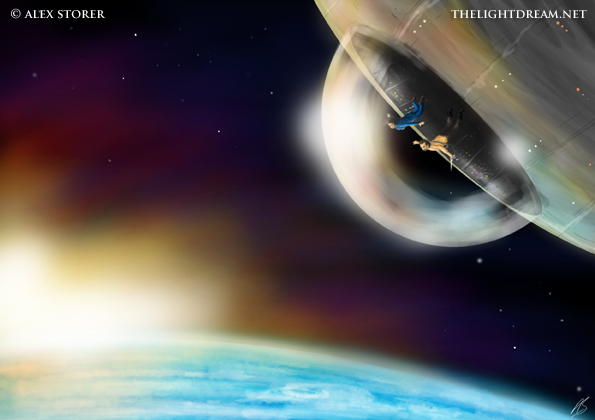Report
By Alex Storer
- Published: Wednesday, January 15 2014 08:54

An inseparable relationship between space, art and music was forged when I was just a boy.
Two albums I’d hear my father playing were Mike Oldfield’s groundbreaking début, Tubular Bells, from 1973, and Jean Michel Jarre’s 1977 breakthrough, Oxygène, which had the most profound effect on. Both albums are today regarded as pioneering masterworks and are still two of my all-time favourite albums that have since inspired my own music. Listen to either album today, and they still sound as unique and exciting as when they first appeared.
On the living room wall at home hung a large print of a painting depicting an alien landscape. A huge star burned bright in the sky, casting long shadows on the mountainous landscape below, the scene caught in a perfect vignette of rocks. You could almost feel the heat emanating from out of the frame. The painting in question was Stellar Radiance by David A Hardy, but I would only find this out years later!
With Jean Michel Jarre’s Oxygène playing, I’d stare out through this portal into another world, fascinated by each element of the painting, eager to step into the scene and explore it. In addition to Stellar Radiance, we also had a book of space and science fiction art by various artists, entitled Space Wars, Worlds and Weapons. Each page was a source of never ending captivation. The sounds of Oxygène seemed to enhance this experience somehow; the bleeps, warbles and swirls of white noise perfectly matching the science fiction scenes of space and spacecraft.
Despite being entirely electronic, the music of Oxygène has an emotive and organic quality to it, somehow making at one with the environment – the album is about the environment after all, carrying a message of climate change. This is perhaps, for me, why this particular album has stayed with me all this time – like much of Jarre’s and Oldfield’s music, it works with nature, whether you’re out in the snow or observing a vibrant sunset. It always forms the perfect soundtrack for those moments in life and it is certainly the influence of their work that made me want to create atmospheric instrumental music (or ‘soundscapes’), rather than conventional pop songs.
It is difficult to say why certain sounds or pieces of music lend themselves so perfectly to space and interstellar visions. Neither are things we can reach out and touch – music stirs our thoughts and emotions, and images of the stars and planets probe our imaginations. We associate music with various moments in life such as a special occasion or a certain place or time; music becomes a soundtrack to our lives. Just like in a good film, the use of a particular piece of music takes the experience to another level, so perhaps when we see the awe-inspiring photographs of the Solar System, we’re naturally inclined to want a musical accompaniment or association (at least for those of us who have not actually been in space!).

Being a synesthete, it is almost impossible for me to separate colours and textures from music – these forms and colours in my mind’s eye become inseparable from the music. The best comparison I can make for anybody who doesn’t experience synesthesia, is that it’s like having the iTunes visualiser in your head!
I had always associated colours and the notion of certain textures with music, but had no idea why until I first heard about synesthesia in Peter Gabriel’s music adventure CD-ROM Eve, in the late 1990s. Suddenly, everything made more sense.
Colours are important when making my own music – where as most musicians would search for a certain tone or instrument sound, I search for a certain colour. Even if this isn’t evident to anybody else in the finished piece, it’s part of how I work, whether I’m aware of it or not.
I always listen to music while drawing or painting. It’s like an integral part of the creative process that I can’t be without. I dare say the choice of album may impact on the artwork, such as the mood or choice of colours. In certain instances, such as when I was working on my Hibernus series of snow/winter themed paintings, I would choose albums with a cold atmosphere and the sort of sounds or moods that I personally associated with the winter climate.
I’ve always been an artist – though my background is in fine art, illustration and graphic design. It was only in 2010 that I rediscovered my love of science fiction and space art and finally decided to try my hand at it. Making music also came much later on for me too. I had briefly dabbled in music software in the late 1990s, but it wasn’t until 2006 that I decided to have another go. I have no formal training at all, just a burning desire to make my own brand of atmospheric, thought provoking and colourful music.
I’ve never been one to follow trends in anything – quite the opposite in fact! I’ve found in the past that keeping up with the current passing trend often inhibits you from developing your work and finding your own style. So when it comes to art, I still go back to the work that I grew up with – artists whose work is still exciting and influential today, such as Chris Moore, Tim White, David A Hardy, Jim Burns, Chris Foss, etc.
Actually, when I look at a lot of the things I like, whether it’s art, music or SF, I often think I should have been born at the start of the 1970s, rather than towards the end of the decade! But to judge something by age is wrong anyway – I think it’s a testament to the artists’ work if people are still talking about it, and citing it as influential today. You just have to look at recent SF blockbusters Oblivion and Prometheus – both took inspiration for their designs from the likes of Chris Foss’ work.

It’s funny how things in life often come full circle. My rediscovery of space art coincided with getting in touch with David A Hardy, and subsequently becoming good friends, and exhibiting alongside him at the UK’s annual Novacon event! Over 30 years on, that same Stellar Radiance print now hangs in my home studio. In 2008, I finally got to see Jean Michel Jarre performing his entire Oxygène album live.
I have often said that making music is just like painting, only using sounds rather than colours (though of course, the colours are still there in my mind!). Just like when I’m working on a digital painting, I build a piece of music up layer by later. It’s also inevitable that that there is some overlap in my art and music. Sometimes I’ll feel the need to make an accompanying piece of music to a painting and vice-versa.
One example is on my 2013 album, Future Worlds. The idea behind the album was that each track would represent a different future scenario – these ranged from climate change on Earth to interstellar flight, the colonisation of other planets and the exploration of alien worlds. A lot of influence came from classic SF literature, and it was also the first album I released as honorary musician for I4IS. I’d had one particular title in my head for a while, ‘The World Outside’. I did not know whether this would end up being a painting or a piece of music but, as it turns out, it became both!
I had a certain mood in mind, the notion of looking at a strange, alien landscape from behind glass, unable to venture beyond it. The more I thought about it, the more I started to think how it could be illustrated musically – and so I began to work on the music, and through that came a small ink sketch, which gradually evolved into the digital painting that became the album cover.
My latest release, Beyond the Boundary, was composed especially for the I4IS, so where Future Worlds carried a strong SF theme, the idea on this new album is purely interstellar travel, thinking of the grand visions of starships and the sights and colours of space. I wanted the music to take the listener on a journey and to have a sense of motion, progress and transition as well as sense of adventure with a hint of uncertainty as we venture into the unknown.

And with those last words came another painting, Into the Unknown. This was my first real painting of a spacecraft, but for the album cover and accompanying digital booklet for Beyond the Boundary, I didn’t want to litter it up with my own work – it was the ideal opportunity to use the work of other I4IS artists, Adrian Mann and David A Hardy, whose stunning work features as the album cover.
Not having my own artwork as the cover actually represented a new challenge to me and that was to create music that would live up to the cover image – no pressure, then!
See more of Alex’s artwork and listen to his music at The Light Dream
You can hear his albums Beyond the Boundary and Future Worlds, produced in association with I4IS.
My Recent Reports
About Me
Contact
| Location: | Florence, AZ United States of America (the)  |
|---|








Comments